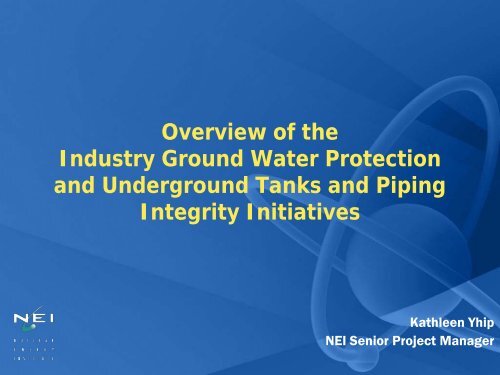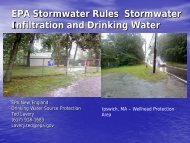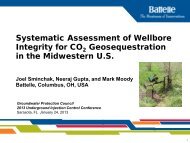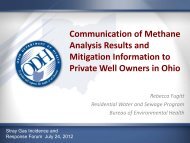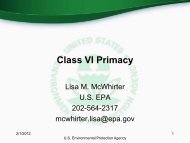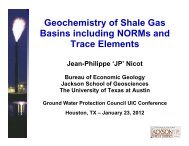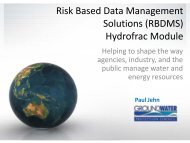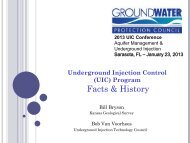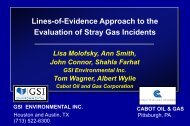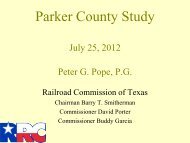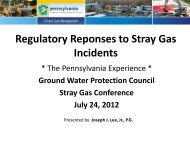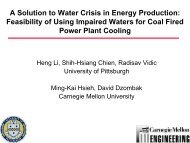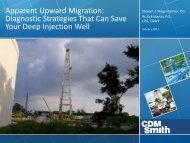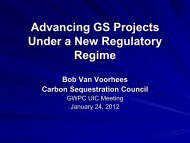NEI Update January 2011 - Groundwater Protection Council
NEI Update January 2011 - Groundwater Protection Council
NEI Update January 2011 - Groundwater Protection Council
Create successful ePaper yourself
Turn your PDF publications into a flip-book with our unique Google optimized e-Paper software.
Overview of the<br />
Industry Ground Water <strong>Protection</strong><br />
and Underground Tanks and Piping<br />
Integrity Initiatives<br />
Kathleen Yhip<br />
<strong>NEI</strong> Senior Project Manager
NRC Requirements Assure Public<br />
Health and Safety<br />
• 10 CFR 20 Subpart D Public dose limits<br />
• 10 CFR 20 Subpart F Surveys & monitoring<br />
• 10 CFR 50.34a Design objectives<br />
• 10 CFR 50.36a Technical Specifications<br />
• 10 CFR 50.75 Recordkeeping for decommissioning<br />
planning<br />
• 10 CFR 50 Appendix A General Design Criteria<br />
• 10 CFR 50 Appendix I Numeric Guidance to meet<br />
ALARA<br />
• 40 CFR 190 Environmental radiation protection<br />
standards for nuclear power plants
Chronology<br />
• Late 1990s – mid 2000s licensed material identified in<br />
subsurface soils and ground water at decommissioning facilities<br />
• November 2005 Nuclear Energy Institute (<strong>NEI</strong>) formed industry<br />
task force<br />
• Chief nuclear officers approved Ground Water <strong>Protection</strong><br />
initiative (GPI): May 2006<br />
– Effective August 1, 2006<br />
– Final Industry Guidance <strong>NEI</strong> 07-07: August 2007<br />
• NRC Liquid Radioactive Releases Lessons Learned Taskforce:<br />
March 2006.<br />
– Report issued September 2006 ML062650312<br />
3
Chronology<br />
• NRC tasking memo on Buried Piping: September 2009<br />
• NSIAC approved Buried Piping Integrity Initiative: November<br />
2009 <strong>NEI</strong> 09-14<br />
– Underground Piping and Tanks Integrity Initiative:<br />
September 2010<br />
• <strong>NEI</strong>-sponsored peer assessments performed 2009-<strong>2011</strong><br />
• Vermont Yankee leak identified: <strong>January</strong> 2010<br />
• NRC <strong>Groundwater</strong> Contamination task force: March 2010<br />
– Senior Management Review Group formed: June 2010<br />
• NRC TI 2515/173 inspections: September 2008-August 2010<br />
4
Chronology<br />
• NRC Commission briefing SECY-11-0019: February <strong>2011</strong><br />
– Industry Initiatives should not become regulations<br />
– Evaluate creating a leading performance indicator<br />
– Evaluate rulemaking on remediation during operation<br />
– Participate in developing consensus standards on piping integrity<br />
• GAO audit of NRC actions, policies, and procedures on buried piping:<br />
report : June <strong>2011</strong><br />
– should periodically evaluate industry’s implementation of<br />
initiatives<br />
– should keep up to date on industry research to develop<br />
technologies for structural integrity tests<br />
• NRC Commission vote on SECY-11-019 August <strong>2011</strong><br />
5
Ground Water <strong>Protection</strong> Initiative<br />
Objectives:<br />
1. Improve management of situations involving<br />
inadvertent releases into ground water<br />
2. Improve communication with external stakeholders<br />
to enhance trust and confidence<br />
Applicable to all U.S. nuclear power plants<br />
– Currently operating<br />
– Decommissioning<br />
– New plants<br />
6
Ground Water <strong>Protection</strong> Initiative<br />
• Action 1: Improve management of situations involving<br />
inadvertent radiological releases that get into ground<br />
water<br />
– <strong>Update</strong> site hydrology and geology<br />
– Evaluate systems, structures, and components and work<br />
practices<br />
– Implement early detection and monitoring<br />
– Establish remediation decision making protocol<br />
– Augment record keeping for decommissioning planning<br />
7
Site Hydrology and Geology<br />
• Review historical data<br />
• Perform site studies<br />
• Identify potential migration<br />
pathways<br />
• Review periodically<br />
• <strong>Update</strong> licensing document<br />
8
Site Risk Assessment<br />
• Identify each SSC and work practice that involves licensed<br />
material that could credibly leak to the environment<br />
• Identify existing leak detection methods<br />
• Identify potential enhancements<br />
– Leak detection systems<br />
– Spill/leak containment systems<br />
• Identify mechanism to track actions<br />
• Establish long term surveillance or preventative<br />
maintenance programs<br />
• Establish frequency for periodic reviews<br />
9
Example of Risk Assessment<br />
10
Ground Water <strong>Protection</strong> Initiative<br />
• Action 2: Improve communication with external<br />
stakeholders to enhance trust and confidence<br />
– Periodic briefings of external stakeholders<br />
– Voluntary communication<br />
• Leaks/spills to the environment<br />
• On-site ground water samples > environmental reporting<br />
thresholds<br />
– 30 day report<br />
– Annual report<br />
• Voluntary communication events<br />
• On-site ground water sample results<br />
11
Voluntary Communication<br />
12
Ground Water <strong>Protection</strong> Initiative<br />
• Action 3: Perform program oversight to ensure effective<br />
implementation of the GPI program<br />
– Independent self assessment<br />
– <strong>NEI</strong>-sponsored peer assessment<br />
• Expectation that sites will address observations and<br />
deficiencies through corrective action program<br />
• Assessments performed at least every 5 years<br />
– Next round of <strong>NEI</strong>-sponsored peer assessments being<br />
planned and will begin shortly<br />
13
Buried Piping Integrity Initiative<br />
• Buried Piping Integrity Initiative approved by NSIAC - November 2009<br />
– Proactive assessment and management of buried piping systems<br />
– Share industry experience<br />
– Drive development of technology for inspection techniques<br />
• <strong>NEI</strong> 09-14 “Guideline for the Management of Buried Piping Integrity”<br />
– <strong>January</strong> 2010<br />
1. Establish procedures and programs – June 2010<br />
2. Perform risk ranking – December 2010<br />
3. Develop inspection plan – June <strong>2011</strong><br />
4. Complete inspections – June 2013<br />
5. Establish asset management plan – December 2013<br />
• Collaborative effort between <strong>NEI</strong>, EPRI, INPO, plants<br />
14
Underground Piping and Tanks<br />
Integrity Initiative<br />
• NSIAC approved expanded scope in September 2010<br />
– Underground piping and tanks whether or not they are in<br />
direct contact with the soil if they are outside of buildings and<br />
• Contain licensed radioactive material or<br />
• Are safety related<br />
• Milestones for <strong>NEI</strong> 09-14 rev 1<br />
1. Procedures and oversight by December 31, <strong>2011</strong><br />
2. Prioritization by June 30, 2012<br />
3. Condition assessment plan by December 31, 2012<br />
4. Plan implementation by June 30, 2013<br />
5. Condition assessment of components containing licensed material<br />
by June 30, 2013<br />
6. Asset management plan by December 2014<br />
15
Initiatives – Common Ground<br />
Oil<br />
Lines<br />
Service<br />
Water<br />
UPTI<br />
GPI<br />
Pits, Ponds,<br />
Lagoons<br />
Chemical<br />
Lines<br />
Vaults &<br />
Trenches<br />
Fuel<br />
Pools<br />
The Ground Water <strong>Protection</strong> Initiative (GPI) and Underground<br />
Piping and Tanks Integrity Initiative (UPTI) have similar objectives<br />
and some overlapping activities<br />
16
Future Activities<br />
• Implement industry initiatives in a committed and enduring<br />
fashion<br />
• Coordinate with UPTI/BPI to improve efficient, effective<br />
implementation of the Initiatives<br />
• GPI: <strong>NEI</strong>-sponsored peer assessments: round 2<br />
• Engage and participate in development of policy changes,<br />
regulations, and regulatory guidance<br />
• Continued operation, license renewal, new plant development<br />
requires that we maintain the trust and confidence of our<br />
stakeholders<br />
17


